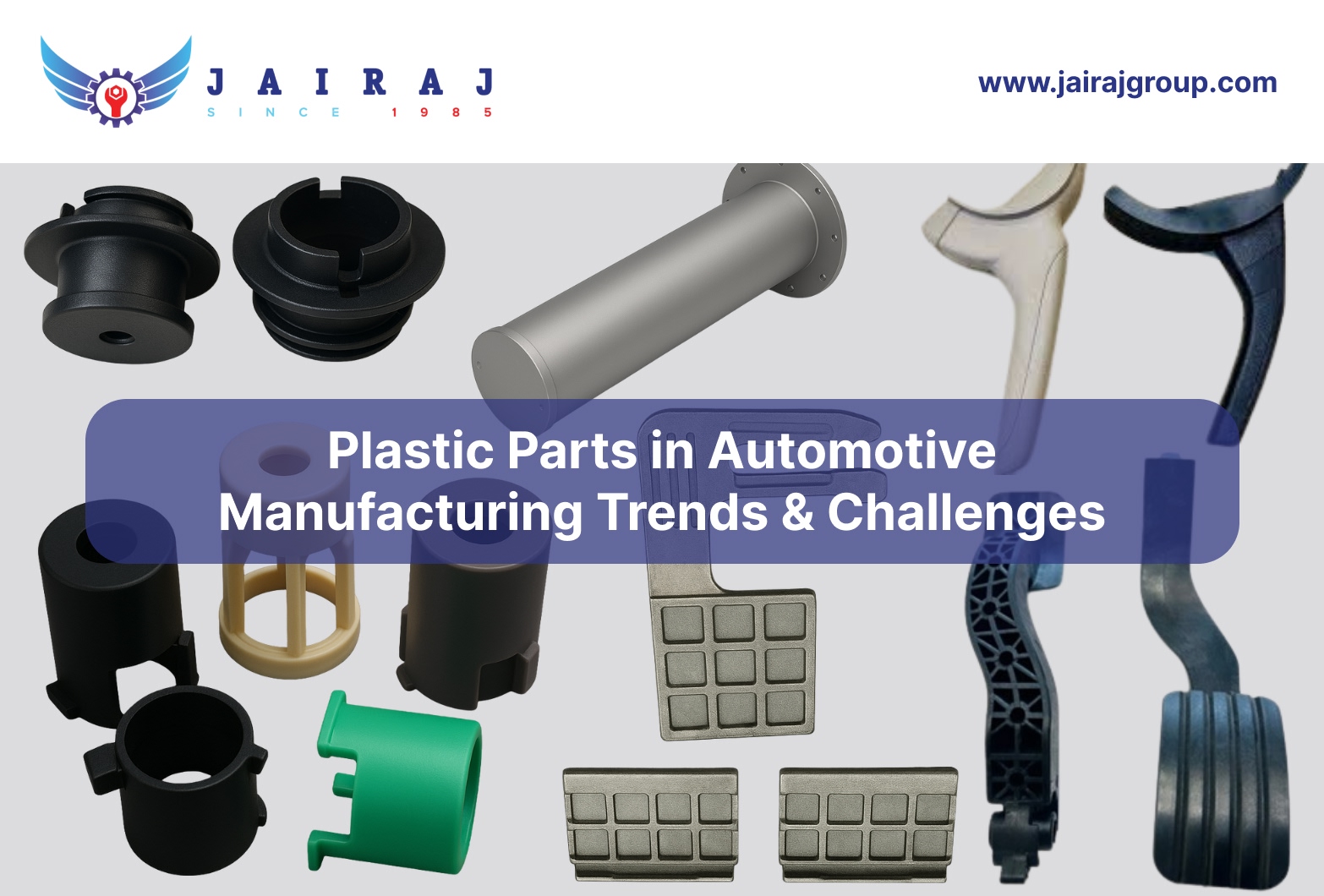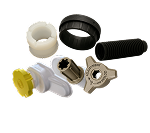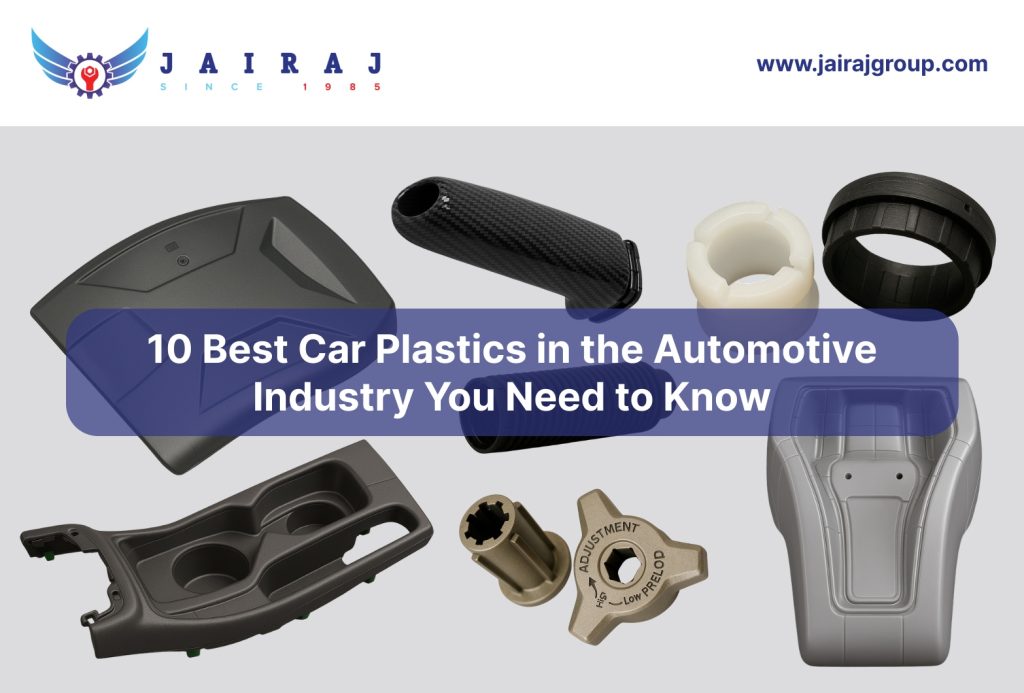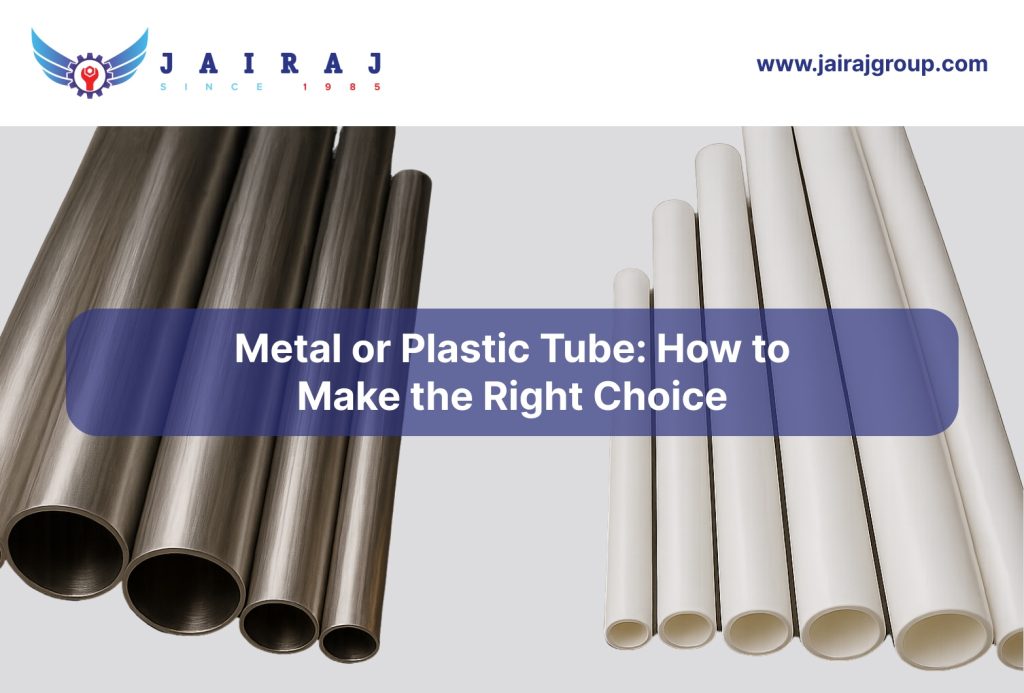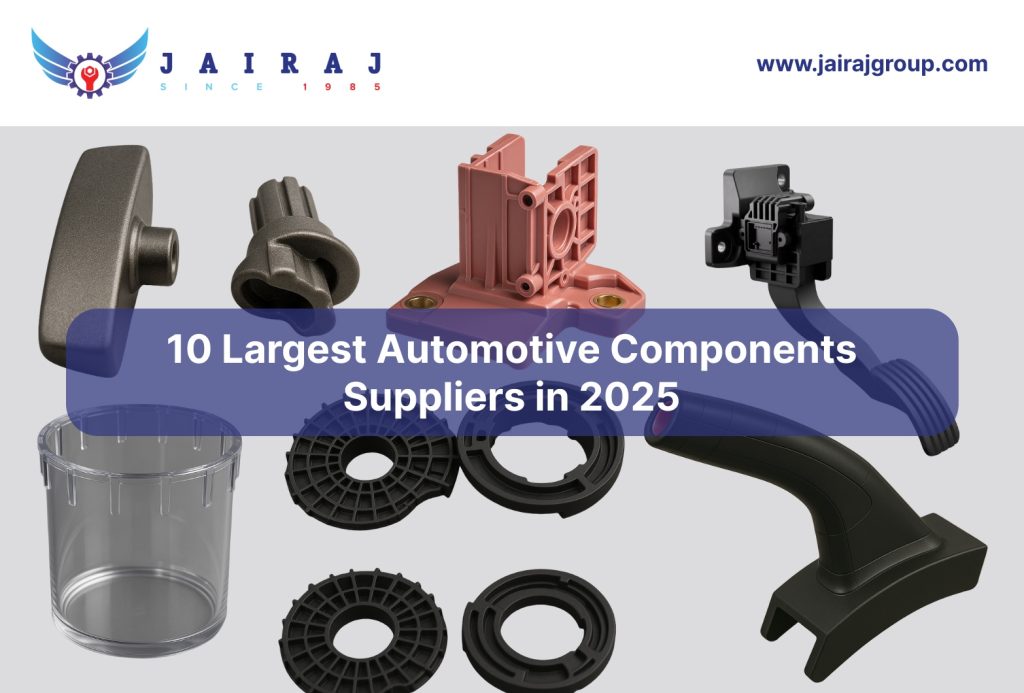The automotive industry is undergoing a transformation, with plastic parts playing a pivotal role in shaping modern vehicles. In particular, the plastic automotive parts manufacturing market in the US is gaining momentum due to the demand for lightweight and cost-effective components. In fact, North America’s automotive plastics market is projected to reach USD 6.80 billion by 2030.
This growth is driven by the demand for lightweight, cost-effective, and durable components. As manufacturers integrate more plastic parts into vehicle systems, they must also overcome challenges related to technology, regulations, and consumer preferences.
In this blog, we’ll explore the manufacturing processes, benefits, trends, and challenges shaping the plastic automotive parts market.
Key Takeaways
- Plastics reduce weight, cost, and enhance design flexibility in automotive manufacturing.
- Injection and blow molding are key processes for high-quality plastic parts.
- The rise of electric vehicles is increasing the demand for lightweight plastics.
- Bioplastics and sustainable materials are gaining importance for eco-friendly solutions.
- Overcoming challenges like material compatibility and regulatory compliance is crucial for success.
Automotive Plastic Parts Manufacturing Processes for OEMs
As automotive manufacturers look for efficient and cost-effective solutions for producing plastic parts, understanding the key manufacturing processes is essential. Here are some key methods driving the production of high-quality plastic components for the automotive industry:
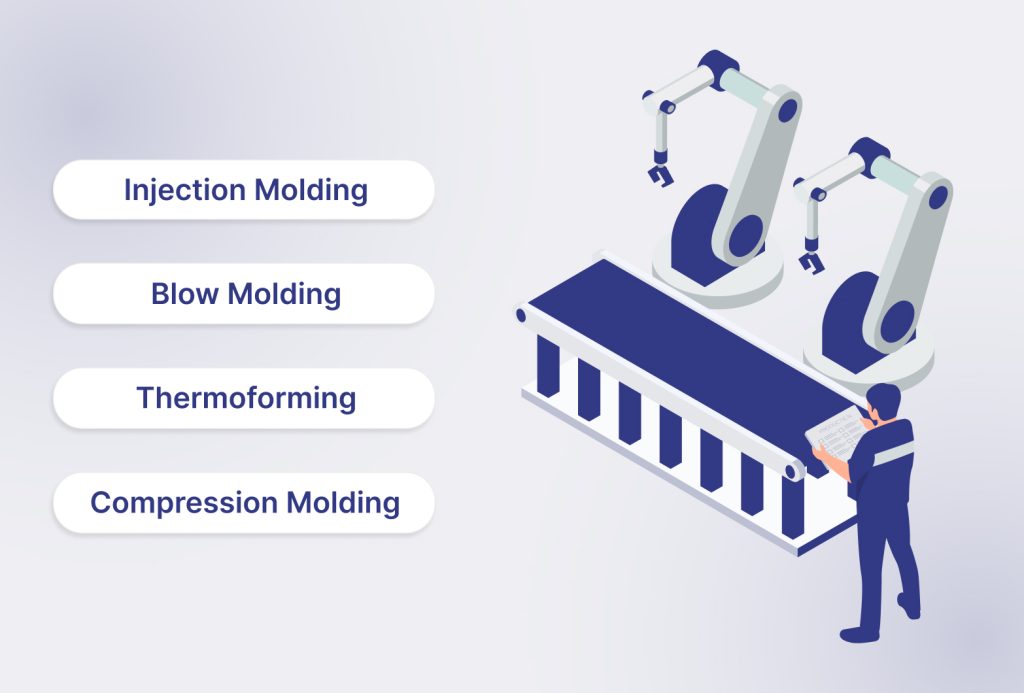
1. Injection Molding
Injection molding is the most common process used for creating plastic automotive parts. This process is highly efficient and allows for the mass production of parts with complex geometries and tight tolerances. Common automotive components produced through injection molding include dashboards, door panels, and exterior trim parts.
2. Blow Molding
Blow molding is used to manufacture hollow plastic parts, such as fuel tanks, air ducts, and piping systems. This method is particularly advantageous for creating parts that require a uniform thickness and need to withstand varying internal pressures, such as gas or liquid storage components.
3. Thermoforming
Thermoforming is a plastic manufacturing process where a sheet of plastic is heated until it becomes soft and then molded into the desired shape using a vacuum or pressure. This technique is commonly used for producing large, relatively simple parts like interior panels, dashboards, and trim pieces.
4. Compression Molding
Compression molding involves placing a pre-measured amount of plastic into a mold cavity, which is then closed and subjected to heat and pressure to shape the part. This process is commonly used for creating large, durable components such as bumpers, fenders, and under-the-hood parts.
Ensure precise, durable automotive components like brake pedals, shockers & suspension components, and plastic bellows & struts with Jairaj Group’s advanced injection molding, blow molding, and rotational molding techniques. With high-performance materials like PA 66-GF, PEEK, and polycarbonate, we deliver components with superior impact resistance, UV stability, and weight reduction.
Also Read: Automotive Interior & Exterior Plastic Parts Manufacturing: Trends and Innovations in 2025
Now, let’s explore the variety of plastic components utilized by the automotive industry.
Top 4 Plastic Automotive Parts for Automotive Suppliers
The integration of plastic components in automotive manufacturing is essential for improving vehicle performance, safety, and design. Here’s a look at the types of plastic components used in automotive manufacturing:
1. Vehicle Bumpers
Plastic is commonly used for vehicle bumpers due to its ability to absorb impact and provide durability. The lightweight nature of plastic helps reduce overall vehicle weight, improving fuel efficiency and safety without compromising strength.
2. Interior Panels
Plastics are widely used for interior panels such as dashboards and door panels. These parts offer design flexibility, durability, and a range of aesthetic finishes, contributing to both the functionality and appearance of the vehicle’s interior.
3. Engine Covers
Engine covers made from plastic help protect the engine components while offering heat resistance. Plastic’s ability to withstand high temperatures and its lightweight nature make it ideal for engine covers and other under-the-hood applications.
4. Cable Insulation
Plastic plays a vital role in cable insulation within automotive wiring systems. It provides electrical insulation, protection from heat, and resistance to moisture, ensuring that the vehicle’s electrical systems remain safe and functional.
Next, let’s look at the benefits of using plastics in manufacturing automotive components.
3 Advantages of Utilizing Plastics in Automotive Manufacturing
Plastics bring several advantages to automotive manufacturing, from lightweight properties to cost-effectiveness. Here are the main benefits of using plastics in automotive parts production:
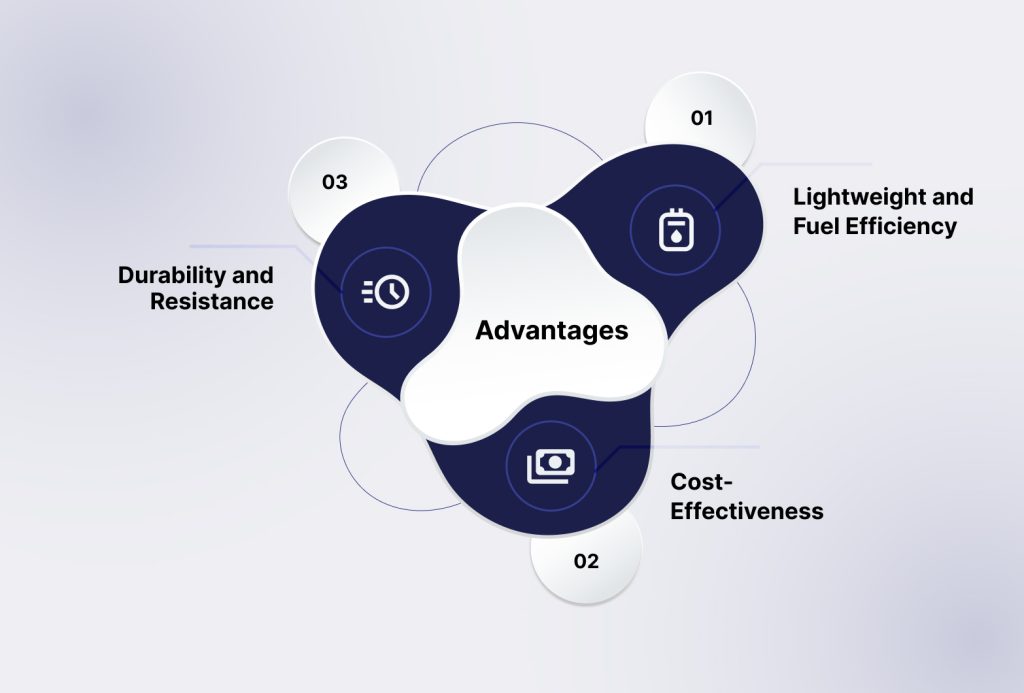
1. Lightweight and Fuel Efficiency
Plastics are significantly lighter than metals, which is essential for improving fuel efficiency in vehicles. The reduction in weight contributes to lower fuel consumption and fewer carbon emissions, making plastic an attractive option for manufacturers focused on sustainability.
2. Cost-Effectiveness
Plastic is often more cost-effective than metals, particularly in mass production. The material is easier to mold into complex shapes, reducing the need for additional manufacturing steps. Additionally, plastics often require less energy to process, lowering production costs.
3. Durability and Resistance
Plastic parts in automotive manufacturing are known for their durability. They are resistant to corrosion, impact, and chemicals, making them ideal for automotive applications that need to withstand harsh conditions. These properties contribute to the longevity of plastic parts, making them a preferred choice for OEMs and Tier-1 suppliers.
Also Read: How to Choose the Right Plastic Product Supplier for Automotive & Industrial Components
As these components continue to change, understanding the trends shaping the market can provide a clearer picture of what lies ahead.
4 Plastics Manufacturing Trends Driving the Automotive Market
As the automotive industry evolves, the trends driving the growth of plastic parts manufacturing are reshaping the market. Here are some of the most prominent trends:
1. Electrification of Vehicles
With the shift toward electric vehicles (EVs), lightweight plastic components are in higher demand. Plastics reduce vehicle weight, improving battery efficiency and range. Parts like battery enclosures and interior panels are increasingly plastic-based.
2. Bioplastics and Sustainable Materials
Bioplastics and recycled materials provide renewable alternatives to traditional plastics, lowering environmental impact while meeting regulatory and consumer expectations for eco-friendly automotive parts.
3. Advanced Materials
Thermoplastic polymers and composites are increasingly used for high-strength, heat-resistant automotive components. These materials enable OEMs and Tier-1 suppliers to produce durable, high-performance parts efficiently.
4. 3D Printing and Additive Manufacturing
3D printing and additive manufacturing allow precise, complex, and customized parts. Rapid prototyping reduces waste, enables small-batch production, and gives manufacturers flexibility in design and lightweight component creation.
While these trends are promising, manufacturers must address key challenges in the industry to continue progressing.
5 Challenges Faced by Automotive Plastic Parts Manufacturers
Manufacturers in the automotive industry face numerous challenges in producing high-quality plastic parts. From regulatory compliance to material compatibility, here are the hurdles that automotive companies face:
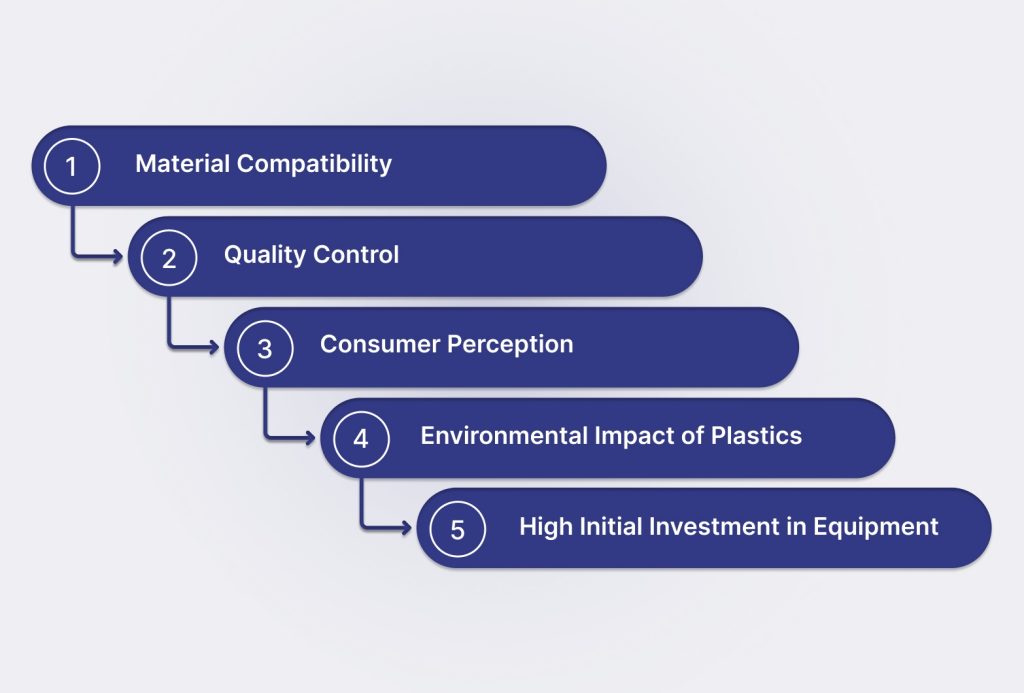
1. Material Compatibility
Ensuring that plastic materials are compatible with metals, glass, or other materials in a heavy vehicle can be difficult. These materials must bond effectively to create a cohesive and functional component, especially when exposed to high stress or temperature variations.
Solution: Manufacturers can explore new adhesive technologies and hybrid material solutions to ensure a stronger bond between plastics and other materials, improving compatibility and durability.
2. Quality Control
Maintaining consistent quality across mass-produced plastic parts is challenging. Variations in the material, processing conditions, and mold design can result in defects, impacting the overall functionality and reliability of automotive components.
Solution: Implementing advanced automation and real-time monitoring during the production process can help detect and correct defects early, ensuring consistent quality and precision in every part.
3. Consumer Perception
Despite the advantages, consumers often perceive plastic parts as inferior to metals in terms of durability and performance. This can hinder acceptance of plastic components, particularly in areas where strength and longevity are highly valued.
Solution: Manufacturers can focus on educating consumers about the advanced properties of modern plastics, such as durability, lightweight nature, and environmental benefits, to shift perceptions and build trust.
4. Environmental Impact of Plastics
Concern over the effects of plastics on the environment, particularly with regard to waste and disposal, is growing. Plastic components must be assessed for sustainability and recyclability as the automotive sector shifts to greener solutions.
Solution: Investing in the creation of recyclable or biodegradable plastics, like bioplastics, can help manufacturers lessen their impact on the environment while still meeting the performance requirements needed for automotive applications.
5. High Initial Investment in Equipment
The initial investment required for specialized plastic molding machinery can be a significant barrier for smaller manufacturers. This high upfront cost can be a challenge for companies looking to scale production without a hefty financial burden.
Solution: Companies can explore cost-sharing partnerships, invest in scalable and modular equipment, or adopt 3D printing for low-volume production, which reduces the need for expensive traditional molds and tooling.
Also Read: Plastic Injection Molding: Precision Thermoplastic Components
Resolving these issues can improve outcomes, particularly when cutting-edge technologies and sophisticated solutions are used.
Upgrade Your Automotive Manufacturing with Cutting-Edge Plastic Components
As the demand for innovative solutions in the automotive industry rises, the plastic automotive parts manufacturing market in the US continues to expand with advanced materials for high-performance components.
Based in India, Jairaj Group delivers state-of-the-art facilities to deliver high-quality plastic components and assemblies to meet the changing demands of the automotive industry.
With certifications including ISO 9000, ISO 14000, and IATF, the company adheres to international standards for precision, durability, and environmental compliance, supporting industries like automotive, defense, and aerospace.
Here’s why Jairaj Group is the ideal partner for your automotive manufacturing requirements:
Jairaj Group manufactures durable, high-precision brake and accelerator pedals for automotive applications. Designed for safety and reliability, these components are built to withstand demanding conditions.
2. Mobility Plastic Seating Solutions
Jairaj Group’s mobility plastic seating solutions offer lightweight, durable seating for automotive, two- and three-wheelers, and railways. These seats combine comfort and efficiency, reducing weight while maintaining performance.
3. Shockers & Suspension Components
Shockers and suspension components from Jairaj Group are engineered to improve vehicle stability and comfort. They are designed to endure high-impact forces, enhancing vehicle performance in automotive and heavy-duty vehicles.
Jairaj Group’s plastic bellows and struts provide flexibility and durability, absorbing shocks and enhancing vehicle longevity. These parts guarantee smoother operation and lower maintenance expenses.
5. Interior & Exterior Accessories
Jairaj Group manufactures interior and exterior accessories, including dashboard components and exterior trims. These parts combine function with aesthetics, ensuring vehicles meet both practical and design needs.
6. Precision Components from Advanced Polymers
Jairaj Group’s precision components made from advanced polymers are used in automotive, aerospace, and defense. These high-durability parts are engineered to meet strict performance standards and tolerances.
If you require brake pedals, shockers, or precision components, Jairaj Group provides high-quality products, expertise and solutions you need to stay ahead in the automotive market.
Conclusion
The plastic automotive parts manufacturing market in the US is growing rapidly, driven by innovation, demand for lightweight materials, and electric vehicles. While plastics offer benefits like cost savings and durability, challenges such as compliance and material compatibility remain.
For companies focused on maintaining a competitive edge and delivering high-quality plastic components, here’s why staying ahead of these trends is crucial.
- High-quality plastic components ensure longer-lasting performance in automotive applications.
- Optimized manufacturing processes reduce production costs while maintaining product quality.
- Tailored solutions that meet shifting market demands, backed by cutting-edge R&D.
By partnering with Jairaj Group, manufacturers gain access to advanced manufacturing capabilities, certified processes, and precision-engineered solutions. With facilities in Faridabad, Rudrapur, Aurangabad, Manesar, and Sanand, Jairaj Group helps businesses innovate, prototype, and scale solutions that meet the dynamic needs of the automotive market.
Contact Jairaj Group today to explore how our plastic solutions can position your company at the forefront of the automotive industry’s evolution.
FAQs
1. What are the benefits of using plastic in automotive manufacturing?
Plastic reduces vehicle weight, improves fuel efficiency, offers durability, and provides design flexibility, making it ideal for both functional and aesthetic parts.
2. How does plastic help in the production of electric vehicles (EVs)?
Plastic reduces the overall weight of EVs, improving battery efficiency and vehicle range, contributing to the overall performance and sustainability of electric vehicles.
3. What are the key challenges in plastic automotive parts manufacturing?
Challenges include material compatibility, high production costs, supply chain disruptions, regulatory compliance, and ensuring consistent quality in mass production.
4. How are bioplastics influencing automotive plastic parts?
Bioplastics provide eco-friendly alternatives, offering renewable materials that help reduce environmental impact while meeting performance standards for automotive parts.
5. What manufacturing processes are used for automotive plastic parts?
Common processes include injection molding, blow molding, thermoforming, and compression molding, each suitable for producing different types of plastic components for vehicles.
6. Why is sustainability important in automotive plastic manufacturing?
By using recyclable materials and reducing waste, sustainability helps manufacturers meet regulatory requirements while satisfying the demands of environmentally conscious consumers.

